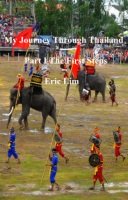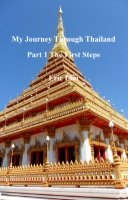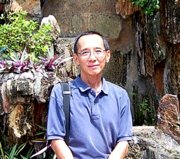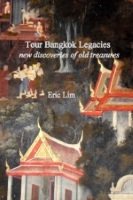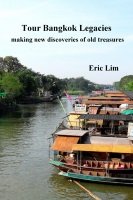- Home
- Bangkok Museums
- Museum of Buddhist Art
Museum of Buddhist Art
a rare collection of Buddha statues
By Eric Lim
The Museum of Buddhist Art in Bangkok is reputed to have the biggest collection of Buddha statues, sculptures and figurines based on Buddhist art work from kingdoms dating back to the 6th century AD.
The exhibits reflect the cultural heritage of the various kingdoms in Thailand and neighboring kingdoms as well.
Visitors to the Museum of Buddhist Art are usually advised to start their tour in an annex to the main building that houses the Kuan Yin Palace and Museum which displays statues of Kuan Yin, the Goddess of Mercy.
The courtyard outside this museum has six miniature wooden palaces housing Chinese deities.
Please see update on location of the museum
The main theme of the Museum of Buddhist Art, however, is housed in eight rooms upstairs in the main building displaying Buddha statues, sculptures and figurines from the different kingdoms that had an impact on Thai art and culture.
The various schools of Buddhist art of each era blended with the previous and added its distinct touch. Detailed explanations are provided for the Buddha statues, their characteristics, different postures and subtle variations in the folds of the robes.
The museum is a useful source of knowledge for the scholar of Buddhist art and Buddha sculptures. The casual visitor, seeking an overview of an important aspect of Thai culture, would find this museum interesting as well.
Buddhist art from the various eras displayed in the Museum of Buddhist Art
Dvaravati art (6th – 11th centuries AD)
Dvaravati art is based on the culture of the United Kingdom of Dvaravati in Nakhon Phahom, Central Thailand established by the Mon from Burma. The Buddhist art work of this period is based on the Southern India and Sri Lanka models.
Srivijaya art (7th – 14th centuries)
The Srivijaya kingdom covered Sumatra, Java, the Malay Peninsula and Southern Thailand, right up to Surat Thani and Nakhon Sri Thammarat. The art form from this era had a rich mix of Indian, Khmer, Sri Lanka, Java and Sumatra cultures.
Khmer art (10th - 19th centuries)
From 6th – 14th centuries, the Khmer Empire in Cambodia ruled over Laos and northeastern Thailand (Isarn). Khmer art was to have an enduring legacy on Buddhist art work for centuries to come.
Burmese art (10th - 19th centuries)
Burmese art evolved from the various ethnic groups in the ancient Burmese kingdom of Pagan. The Burmese, Mon, Arakan, Tai-yai kingdoms developed Buddhist art during their respective reigns. All these groups had an influence on Thai art.
Sukhothai art (13th – 15th centuries)
Art flourished in the Sukhothai Kingdom under the reign of King Ramkhamhaeng. Classic Sukhothai art soon emerged from the Khmer influence and established its unique style.
Ayuthaya art (1350 – 1767)
The exhibits on Ayuthaya art in the Museum of Buddhist Art represents the longest period in Thai art. Pre-Ayuthaya art was a combination of Khmer art of the Bayon period (the Bayon temples in Cambodia) and Dvaravati art, a mixture which was known as U Thong Art.
The establishment of Ayuthaya produced a blend of Khmer and Sukhothai styles which gradually evolved into its own distinctive character in the 16th century.
Lanna art (13th - 20th centuries)
The Lanna kingdom (Land of a Million Fields) was established by King Mengrai in northern Thailand in 1296. Pure Lanna art developed when the kingdom was independent. Lanna came under Burmese rule and later under Thai rule. The Buddha statues during these periods had their subtle differences.
Lan Xang art (14th – 18th centuries)
The Lan Xang kingdom (Land of a Million Elephants) was founded by King Fah Ngum in the 14th century after the fall of Sukhothai. The kingdom covered present day Laos and parts of northeastern Thailand. King Fah Ngum made Buddhism the state religion and so began an art form that also left its mark on Buddhist art.
Thonburi art (1767 – 1782)
Thonburi art had a brief period as the kingdom lasted for only 15 years.
Rattanakosin art (1782 – present)
What followed was Rattanakosin art of the modern Bangkok era. The Buddha statues and sculptures during the reign of the Chakri Kings developed a distinct identity of their own.
The other eight rooms in the Museum of Buddhist Art are not directly related to the central theme but are equally interesting.
These cover artifacts from the pre-historic Ban Chiang culture, Yao paintings, stone sculptures.
An unusual set of exhibits in this museum is the room displaying statues of Jesus Christ and Mother Mary, a reflection of the religious tolerance in Buddhist society.
The Museum of Buddhist Art embodies not just the art and culture evolved for more than a millennium through the rise and fall of several kingdoms. It symbolizes the philosophy of moderation and tolerance, values that serve as a beacon of light in these troubled times.
Location of the Museum of Buddhist Art
Please note that the museum is no longer at Soi Patthanakarn 40. It has moved to new premises currently under construction in Pattaya Klang Road. The new museum is expected to be ready by March 2015.
For enquiries please call +66 2321 0048 - 52 or +66 2322 2434
My thanks to Arya Pathammavong for informing us of this change.
Update on the location of the museum
Please note that the Museum of Buddhist Art has opened in the new premises in Nong Prue, Bang Lamung in Chonburi on 1 November 2015.
The new address is
Nongmaikaen Road
Tambon Nong Prue
Amphur Bang Lamung
Chonburi
Tel: 038 195 224
Map to the Museum of Buddhist Art
If the map doesn’t appear, click on this link
How to get there
By bus
Take a bus from the Eastern Bus Terminal at Ekamai to the Pattaya Bus Terminal in North Pattaya Road. From there you will have to take a taxi or tuk tuk to the museum.
By car
Go along Sukhumvit Road till you get to Sukhumvit Pattaya Soi 53 which is opposite the Central Pattaya. Turn left into Soi 53 and proceed on to Noen Phlap Waan Road.
When you get to Wat Sutthawas, turn left then right into Nongmaikaen Road. Proceed along Nongmaikaen Road till you get to the junction of Nongmaikaen Soi 19.
The Museum of Buddhist Art is located at the junction of Nongmaikaen Road and Soi 19.
Opening times
Every day from 0800 – 1700
Admission 100 baht for adults
To return to the other Bangkok Museums.
My Journey through Thailand Part I The First Steps
This is my second e-book and the first in the series of travel journals on my trips to explore the various provinces in Thailand. This edition, which covers my travels from late 2009 to mid-2013, will guide you to historical sites, cultural monuments and exquisite Thai handicraft, across a vast spectrum of cultural and ethnic diversity.
You can have a virtual tour with this e-guide book or take the first steps yourself in this journey through Thailand.
My Kindle e-book
